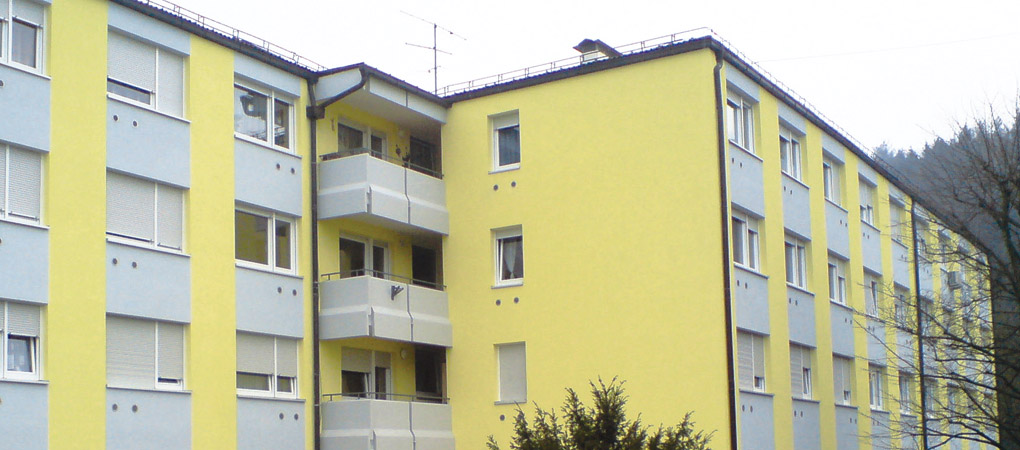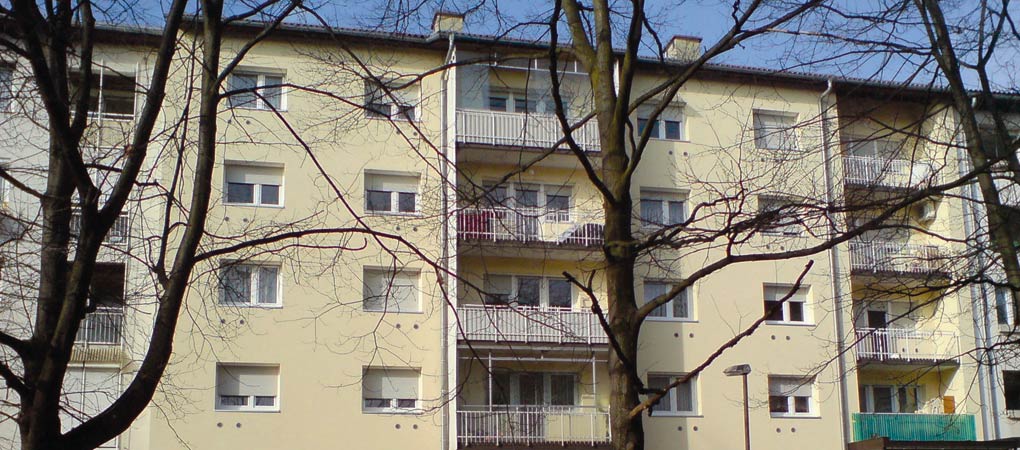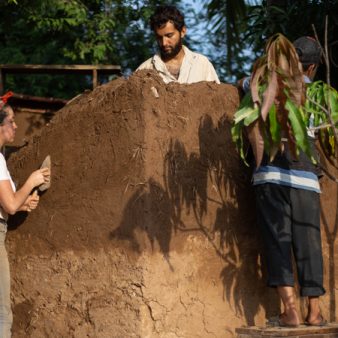The Public Housing Fund of the Municipality of Ljubljana (The Fund) is the organisation in charge of the implementation of the national housing programme in Ljubljana, the capital of Slovenia. The Fund was set up to manage all aspects of the municipality’s housing programme in Ljubljana, developing and implementing policy, organising lines of credit from financial institutions, allocating funds and managing properties. It currently carries out the full range of landlord responsibilities, including energy-efficient refurbishments of existing properties, as well as adding to its existing dwelling stock by building low energy/passive housing. Surveys have shown that residents are proud to live in environmentally-friendly buildings that are refurbished to a high standard. The Fund’s activities have had positive socio-economic impacts on surrounding areas.
Project Description
Aims and Objectives
The main aim is to improve the energy consumption in rental apartments in the municipality of Ljubljana, by both retrofitting existing housing stock and by building low energy/passive housing.
Context
The collapse of the communist system in 1991 led to the large scale privatisation of the housing stock in Slovenia, with all tenants being given the option of purchasing their apartment, at a very high discount. Prior to privatisation there had been 12,000 municipally-owned dwellings in the city of Ljubljana (12 per cent of the stock) but now there are only 3,200 municipally-owned non-profit rented dwellings. Today, 88 per cent of the stock is owner occupied and this is seen very much as the preferred option. There are a large number of applicants for rented dwellings due to the high cost of rent in the private sector, but only a limited number of additions to the Fund’s housing stock each year, due to the high price of urban land and limited financial resources.
Historically, the Fund had problems with tenants not paying rents and other maintenance costs (partly because there has not been a culture of paying rent), which was a cause of (often long) disputes between tenants and managers of low-cost apartments. Staff at The Fund recognised that this problem might be solved by reducing housing and maintenance costs and at the same enhancing the quality of living conditions in those dwellings. So during last eight years, the Fund has striven to reduce running costs and to make charges as consistent as possible, while enhancing the quality of living conditions.
Key features
The main activities of the project are to refurbish the existing housing stock and to construct new stock that is energy efficient. Projects have been undertaken in degraded parts of the city. The first project carried out was the refurbishment of an existing block where 57 apartments were created from the existing building with high levels of energy retrofit. Typical work carried out included putting external insulation (+20cm) on the outside walls, basement floor and attic ceilings, and replacing windows and doors with energy efficient versions with eternal thermal shutters.
Other similar retrofits were carried out on other typical post-war blocks where all the flats were in the sole ownership of the municipality. In total a further 80 flats have been completed. Existing tenants were given the choice of decanting while the work was in progress or staying in their homes. There were detailed consultations with the engineers and builders, and residents chose to stay while the work was carried out. Typical work carried out included putting external insulation (+15cm) on the outside walls, basement floor and attic ceilings, and replacing windows and doors with energy efficient versions. Eternal thermal shutters and mechanical ventilation systems with 75 per cent heat recovery were also installed. As a result the energy consumption fell dramatically. In 2008/09 it fell to 50 Wh/m2/annum from 80Wh/m2/annum, i.e. a reduction of nearly 40 per cent. On the other new-build developments different solutions are used, such as liquid earth heat exchangers to preheat / pre-cool the outside air in a passive way.
Hygro-sensible ventilation systems are used to regulate air intake. This is a very cheap and easy system to install and allows ventilation without opening windows, with the result that the indoor climate is healthy, without mould or condensation. These systems are widely used also in Germany and Austria. Consultation and training in how best to maximise the new energy system was carried out and is regularly updated.
These technical activities have gone hand in hand with the implementation of new building legislation in Slovenia and the development of new technologies. The refurbishment works were completed in 2005 and 2007. Four new-build developments providing a total of 234 new apartments built to the PassivHaus standard are currently in progress with completions expected in 2011. This standard uses high levels of insulation, careful design and mechanical ventilation to ensure that the total energy demand for space heating and cooling is less than 15 kWh/m2/yr treated floor area, and that the total primary energy use for all appliances, domestic hot water and space heating and cooling is less than 120 kWh/m2/yr.
Covering costs
A range of resources have been deployed by the municipality to carry out the refurbishment work to date. These include the municipalities’ own resources and loans from the Slovenian Environmental Public Fund (SEPF). The total cost of the refurbishments was €866,000 (US$1,248,000), of which 20 per cent came from the municipality’s own resources and 80 per cent from SEPF loans (repayment is over 15 years at Euribor + 0.3 per cent, i.e. currently 1.014 per cent in total). For the new construction projects the costs were met entirely from the Fund’s own resources, except for one project which was half funded by the National Housing Fund (NHF).

Impact
- These projects are carried out in degraded parts of the city and these new constructions have had positive socio-economic impacts on surrounding areas.
- Fuel consumption and the associated carbon emissions have been reduced and a greater awareness of the need to save energy has been developed, in both the private and social housing sectors. Schools and kindergartens are also being built to low energy standards.
- Tenants are now much happier with their accommodation and more prepared to pay rent. According to resident surveys, residents in general are proud and happy to live in a refurbished building, which is of a higher standard compared to other privately owned blocks of similar construction and age in the vicinity.
- Legislation has been passed to ensure that all new buildings in the city, both private and public construction, must be designed to a low energy standard and must incorporate renewable energy sources available on site. In addition, the building design must include an assessment of how these requirements will be fulfilled.
- Ljubljana City policies now have a much greater emphasis on urban sustainability, addressing urban issues such as sprawl, public transportation etc. The example of the capital city is increasingly being taken up by other towns and cities in Slovenia.
Why is it innovative?
- Highlighting the need to address the poor energy performance of the Slovenian rental housing stock, since this had never been a concern in the country or in the former Eastern Bloc more broadly.
- Utilising the highest possible refurbishment and development standards for the provision of social rented housing.
- Using innovative technical solutions, including renewable energy systems in the development of the new stock, as well as in the refurbishment of the existing stock.
What is the environmental impact?
- Wherever possible, materials with low embodied energy were used in the refurbished buildings and have been specified for the new constructions.
- There has been a reduction in energy usage and carbon emissions in both new and existing housing blocks in Slovenia. A range of technologies are used including hygro-sensible air inlets and energy efficient ventilators, common exhaust ventilators with automatic volume regulation, local ventilation units with high heat recovery, pre-cooling and pre-heating of air with liquid earth heat exchangers, solar thermal and PV systems.
- The use of brownfield sites makes better use of existing city spaces, reduces the need for transportation and the other negative aspects of urban sprawl.
- Awareness-raising is an important part of the project with a wide range of public exhibitions and information sharing, as well as schools events in 16 elementary schools and six high schools and the Technical Museum of Bistra. A website was established to provide further information.
Is it financially sustainable?
- Since this is a municipal government project, one of the key determinants is the ongoing political commitment. The city’s very strong will to carry out this work is supported with long-term incentives from the EU.
- The project does not provide any extra skills or capacity to improve their longer term income earning potential, although additional temporary jobs have been created through the construction programmes.
- There have been significant reductions in energy bills for residents in the apartments as a result of the energy consumption falling dramatically.
What is the social impact?
- The Fund has been very active in disseminating information about its work with the residents. A series of meetings have been held with existing residents in the retrofit blocks, along with possible new residents for the blocks that are in the process of design and construction.
- All tenants are individually instructed in how to manage their heating systems and have a greater involvement in the management of their apartments.
- Living in warmer accommodation has reduced the incidence of condensation and improved the health of residents. The ventilation system ensures that there is better indoor air quality and there are noticeably fewer health problems, particularly amongst children.
- The improved quality of accommodation in the social rental sector improves the status of social housing tenants. These are the people who could not afford to buy their home when the state achieved its independence and therefore felt stigmatised. Living in some of the better accommodation in the neighbourhood helps to increase their self-esteem.
Barriers
- Training was needed for the engineers since they were not familiar with new technical solutions, and this included training on the job as the work progressed.
- How to get enough money to build the projects was, and still is, a perennial problem for the new EU member states as they seek to develop their economies and build up their financial capacity to invest in their human settlements. These problems have been exacerbated by the recent downturn in the global economy.
- Most blocks contain both tenants and owner occupiers. Work can only proceed if the owners are prepared to pay their share of the costs. The two blocks refurbished to date had no owner occupiers in them.
Lessons Learned
- Every project is different and every project needs special analysis, not only in respect of the site capacity but also in terms of future users of the buildings.
- The need for teamwork is important throughout the project, but especially during the design and construction phases.
- It is essential to involve tenants in all discussions at every stage, in order to ensure that they have maximum information on how to best use and live in the dwellings and thus maximise their energy savings.
Evaluation
- The overall energy consumption in the blocks is being monitored on a regular basis. In the new build projects, on-line energy metering will be provided for each flat.
- Residents are contacted twice a year during periods of maintenance and the Fund uses this opportunity to interview the users and monitor their satisfaction.
- Recent monitoring of household structure has shown that previous assumptions were wrong. For example, 30 per cent of households were one-person households whereas it was assumed that this was 10 per cent. New developments have been designed to reflect the current population profile.
Transfer
- Starting with the retrofit of a single block, the project has continued to develop both its retrofitting and new build construction programmes. In addition to the projects already completed or in progress, three additional schemes are planned to provide accommodation for a further 44 people, including 14 young people with complex problems. The Fund is limited at present to retrofitting those blocks where it has sole ownership of all apartments, as private owners are less willing to invest in the retrofit work.
- Two large exhibitions were held in 2008 and 2009; these were attended by over 2,000 visitors. The exhibitions included opportunities for guided tours of the completed blocks by the designers and technical workshops alongside an architectural exhibition. The presentations and workshops have encouraged other organisations to consider their ideas and approaches, especially in the private sector, where commercial investors found that social housing was offering higher standards than they were.
- The development of an EI-Education programme for social housing companies and a practical guidebook for social housing companies on energy intelligent retrofitting are both ongoing initiatives.
- Partnership with NHF has resulted in the construction of a low energy housing development of 54 apartments in Ljubljana. NHF has adopted the standards pioneered by the Fund in Ljubljana and redesigned its ongoing investment and now has 600 flats in new projects throughout Slovenia being built to these higher environmental standards.
- The Slovenian experience has been shared with the other EU cities participating in the REBECEE programme (Alingsas, Amsterdam, Kiel, Riga, Tallinn, Sofia and Vilnius).
Partnership
Local government, Local community, Central government



